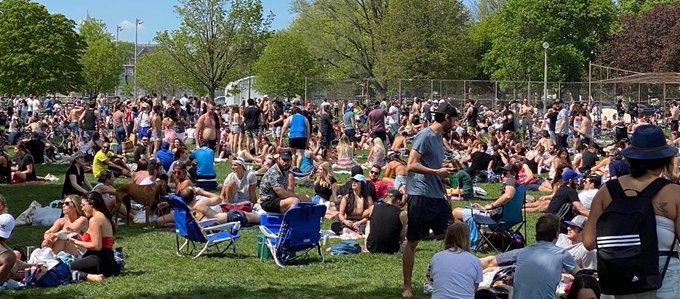Trumpstyle said:
Don't you think it's possible that the immunity level is just much higher then the antibody tests show. I just can't see how Stockholm have manage to reduce their confirmed cases by 50% from the peak. I read on twitter that the antibody tests can't pick up something called T-cell immunity and that even the best antibody test has somewhere 97-98% sensitivity so if someone has low amount of antibody the test can't pick it up. I'm thinking something like 35% of Stockholm has been infected today. The confirmed cases are going down while the behavior is getting worse according to this apple mobile tracker. Köra = Drive/Car As for Canada, I'm sure you guys will do just fine. It's time to reopen things, but at a faster pace. |
Those are routing requests, which could very well be to parks that see increased visits. Hence the more detailed Google data I posted is a better way to see what's going on.
Retail and transit stations are still well down, work places and groceries also still down. Despite the increase visits to parks, on average people still stay inside more.
What happened is that people got smarter. Better protection of the vulnerable and people participating in social distancing measures which does not show in mobility trends. Hence the projections of the imperial college reports have a big disclaimer that those are pessimistic projections. They are made based on what would happen with increased mobility, yet without taking social distancing measures and improved work place safety into account.
1. The Apple data are routing requests while parks are seeing the biggest increase in mobility with the lowest risk.
2. The Google data shows much less increase in mobility for the things that count most towards increased spread.
3. People have been adjusting to 'the new way of life', being more careful while increasing their mobility.
Sweden has seen the slowest decline and longest drawn out peak in Europe, yet as with all, the biggest decline happens first when recovering from a peak. That peak is not only from current infections, it's amplified by ramping up testing and finding a lot of already longer ongoing cases.
The peak in Ontario was 634 reported cases (Apr 23) which dropped down to 294 (May 10), filtered the drop was 47% (595 -> 316)
And now we're posting just over 400 a day again.
All these swings are part of delayed human reactions, a feedback loop.
Numbers seem much better than bad spots/countries, people stick to a waiting game.
Numbers start going up fast, people get serious.
Numbers start going down fast, people get anxious to return to normal.
Numbers stop slowing down, hopefully people get serious again.
Edit: Ontario already put its numbers up, higher again +460. However pending tests dropped by 2500, so perhaps a part of the 460 belonged to yesterday, not that that matters much. A full week of increasing daily cases, 3 day avg growth rate of 121% week over week atm.
This week 2,847 reported cases
Last week 2,412 reported cases
118% change compared to a full week ago, 1.024x daily growth, 29.3 days to double, so still plenty of time to adjust course.
Hopefully it will sort itself out and the recent increase is from people getting excited to get out again.
Anyway phase 2 should be delayed by a week I would think, 2 weeks of consistent decline was the requirement.
https://toronto.ctvnews.ca/ontario-records-another-spike-in-new-covid-19-cases-1.4952266
Sunday’s report marks the highest number of new cases reported in Ontario since May 8. when 477 new cases were confirmed. The rise represents a 1.8 per cent increase over yesterday's total.
Trinity Belwoods, Toronto, yesterday
https://toronto.ctvnews.ca/grow-up-toronto-councillor-warns-people-who-packed-downtown-park-1.4951997





















 Essay Pro
Essay Pro